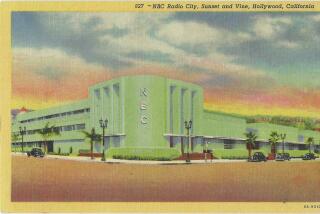Volunteer Deejays Keep Jazz on Air in S.D. : Radio: Tiny City College station is dedicated to making sure that San Diegans can keep tuned in to the sounds of jazz.
SAN DIEGO — A saxophone wailed from somewhere down a deserted hallway. The heart-rending sound came through a far-off open door. In a tiny booth equipped with CD players, turntables, a microphone, assorted electronic equipment and an array of knobs and buttons, KSDS disc jockey Ron Galon worked jazz magic.
Dressed in shorts and a tank top on a Saturday night, Galon delivered set after set of jazz, mixing longtime jazz players such as Pat Metheny with lesser-knowns such as Bob Berg. Galon has been host of a three-hour show on Saturday nights since 1985. During the day, he works as a communications technician for AT&T;, but he thrives on his unpaid KSDS nights.
Ricky Joe Rand took Galon’s place at 9. He sells hair-care products for a living, but this Saturday night, he was doing what he loves more than anything: filling in for regular host “T” on the station’s 9-to-midnight blues show. While a Lightnin’ Hopkins tune wound down, Rand kept busy, flipping the next CD into a player, pushing a public service announcement cartridge into a tape machine, answering questions.
Galon and Rand are but two of 60 unsalaried but professional-sounding disc jockeys who play music from 6 a.m. to midnight five days a week, and until 2 a.m. Fridays and Saturdays. They choose from among 7,000 records and 2,000 CDs.
Like the old underground rock ‘n’ roll radio stations of the 1960s, KSDS, on the campus of San Diego City College, places the emphasis on music. Long, artfully composed sets of songs reflect each disc jockey’s personal tastes, not the results of market research.
To purists, KSDS is the only true jazz station in town, the only consistent outlet for the music whose legends include Louis Armstrong, Charlie Parker, Lester Young, Coleman Hawkins, Miles Davis, Oscar Peterson and many others.
There have been no formal surveys as to the size of its audience, but General Manager Jim Dark, also dean of the college’s Radio/Television Department, estimated that 40,000 people tune in during the course of an average week.
“It’s kind of a rule of thumb that you multiply your weekly inquiries by 100 to estimate your audience,” said Dark, who guessed that the station receives roughly 400 letters and phone calls per week.
By contrast with other stations, KSDS’s 841-watt signal (88.1 FM) is barely a blip. Light jazz-pop station KIFM (98.1), for example, boasts 28,000 watts.
“Our signal probably takes us south to Chula Vista, midway through El Cajon and north through Del Mar,” Dark said. Maybe, but the sound can be spotty, especially in a moving vehicle. For at least a decade, each year’s community college budgeting process brings talk of a new transmitter and an upgrade to 2,000 watts, but so far it hasn’t happened. Dark said he hopes for the resolution of some technical obstacles, but he couldn’t say when.
KSDS radio is available to subscribers of several local cable television systems, including Cox, Southwestern, Times Mirror/Dimension and American Cablevision/Televents. Cox alone presents a potential audience of 299,000, but KSDS has barely scratched the surface. Few cable subscribers know that by hooking up their FM receivers to the cable, they can get better reception and more stations, including KSDS. Cox charges $15 for FM connection and $3.95 per month for radio service.
Although the matters of power and reach are in limbo, the station’s sound continues to evolve.
Several shows each week include interviews with a variety of local and internationally known jazz performers. Art Blakey, Max Roach and Tony Williams have all appeared on San Diego drummer Barry Farrar’s “Percussive Profiles” program, which airs Mondays from 3 to 6 p.m. Stan Getz and Carmen McRae chatted with KSDS jock Tony D. earlier this year, and Chick Corea was on Tom McManus’ “Piano Perspectives in April.
Longtime on-air personalities like Scott Harrison (“Friday Night Countdown”), Pat Allen (“Jazz Live,” Tuesday nights), Miff Mole (“Free Time,” Thursday nights) and “T” (“Every Shade of Blue,” Saturday nights, and Wednesday night jazz) are constantly supplemented with new programming and talent.
Shows added during the past year include “Instrumental Women,” with Janine Harty Wednesdays at 2 p.m., “Le Jazz Club,” every other Sunday night at 7 (tapes of European club dates), and, on Sunday afternoons at 1, McManus’ piano program.
Last month, veteran jazz aficionado Rod Page began a Sunday afternoon show from 4 to 6. Page drove a bus for Duke Ellington, was master of ceremonies for Stan Kenton and had a jazz show on KFMX, a jazz station in La Jolla during the late ‘50s and early ‘60s. He regales listeners with first-hand stories about the greats of jazz.
“What we’ve done is add specialty shows, but within the jazz mainstream,” said Tony Sisti, the station’s program director. “We’re a music intensive station. All we’re trying to do is preserve an American art form that is dwindling.”
KSDS went on the air in 1951 but didn’t go all-jazz until 1973.
“At the time we switched, a particular core of students was very interested in jazz,” said Hope Shaw, the station’s manager, also an instructor of radio-television. “We felt we were an urban college, and that a lot of our constituency was very interested in the roots of jazz, or might be, and there was no jazz station in the community. We didn’t want to be simply a college station that was so eclectic we didn’t serve anybody.”
Since the early years, the station has grown in many ways. An annual budget of about $54,000 comes from the community college district. KSDS is also exploring underwriting, the same kind of financing that helps keep public television and radio afloat.
Disc jockeys and management will soon have a much better idea of who their listeners are and what they want.
“We know absolutely nothing right now,” Sisti said. Last week, 1,500 surveys went out to listeners, and Sisti hopes 5,000 more will call in to request the forms.
In the meantime, Sisti is counting on a crew of rising young mainstream jazz players to help KSDS carry the jazz flame.
“What you have right now is a lot of young lions coming up, trying to preserve the tradition. I’m talking about trumpeters Roy Hargrove and Marlon Jordan, the organist Joey DeFrancesco. It’s a long list. These are people who are keeping jazz alive. They don’t get played on commercial radio.”
More to Read
The biggest entertainment stories
Get our big stories about Hollywood, film, television, music, arts, culture and more right in your inbox as soon as they publish.
You may occasionally receive promotional content from the Los Angeles Times.










